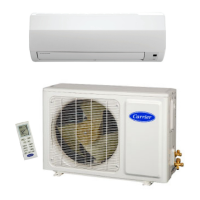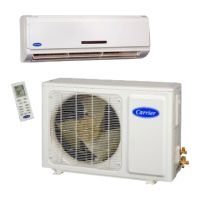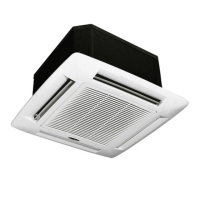Do you have a question about the Carrier 40GVM-009 and is the answer not in the manual?
Warning about explosion risks from oxygen mixtures and pressurized systems.
Warning regarding electrical shock precautions and disconnect switch use.
Caution regarding improper operation causing equipment damage.
Specifies the acceptable outdoor temperatures for cooling operation.
Specifies the acceptable outdoor temperatures for heating operation.
Details voltage, current, and fuse/breaker ratings for outdoor units.
Details voltage and fan current ratings for indoor units.
Shows how to connect power and control signals between units.
Identifies key components like heat exchangers and expansion valves.
Illustrates the path of refrigerant through system components.
Detailed steps for deep vacuum evacuation using a pump and gauge.
Alternative method for evacuation using nitrogen and vacuum pump.
Steps for diagnosing issues, including power supply confirmation.
List of error codes, their descriptions, and affected units.
Detailed error codes for sensor issues and mode conflicts.
Explains the meaning of LED indicators for various malfunctions.
Steps to check and resolve IPM protection malfunctions.
Procedure to diagnose compressor issues via wiring and resistance.
Steps to diagnose and resolve PFC protection errors.
Steps to diagnose and resolve capacity charging malfunctions.
Steps to diagnose and resolve high temperature/overload issues.
Steps to diagnose and resolve temperature sensor issues.
Steps to diagnose and resolve compressor start failure.
Troubleshooting for communication issues affecting specific indoor units.
Troubleshooting for communication issues affecting all indoor units.
Steps to diagnose and resolve compressor overload/discharge protection issues.
Steps to diagnose and resolve compressor desynchronizing issues.
Troubleshooting steps for communication failures between units.
Steps to take when the unit or system fails to operate.
Troubleshooting steps for cooling performance issues.
Steps to remove the faulty compressor.
Steps to install and connect a new compressor.
Steps to remove the existing 4-way valve.
Steps to install and connect a new 4-way valve.
Steps to remove the existing electronic expansion valve.
Steps to install and connect a new electronic expansion valve.
Steps to remove the existing liquid separator.
Warning about explosion risks from oxygen mixtures and pressurized systems.
Warning regarding electrical shock precautions and disconnect switch use.
Caution regarding improper operation causing equipment damage.
Specifies the acceptable outdoor temperatures for cooling operation.
Specifies the acceptable outdoor temperatures for heating operation.
Details voltage, current, and fuse/breaker ratings for outdoor units.
Details voltage and fan current ratings for indoor units.
Shows how to connect power and control signals between units.
Identifies key components like heat exchangers and expansion valves.
Illustrates the path of refrigerant through system components.
Detailed steps for deep vacuum evacuation using a pump and gauge.
Alternative method for evacuation using nitrogen and vacuum pump.
Steps for diagnosing issues, including power supply confirmation.
List of error codes, their descriptions, and affected units.
Detailed error codes for sensor issues and mode conflicts.
Explains the meaning of LED indicators for various malfunctions.
Steps to check and resolve IPM protection malfunctions.
Procedure to diagnose compressor issues via wiring and resistance.
Steps to diagnose and resolve PFC protection errors.
Steps to diagnose and resolve capacity charging malfunctions.
Steps to diagnose and resolve high temperature/overload issues.
Steps to diagnose and resolve temperature sensor issues.
Steps to diagnose and resolve compressor start failure.
Troubleshooting for communication issues affecting specific indoor units.
Troubleshooting for communication issues affecting all indoor units.
Steps to diagnose and resolve compressor overload/discharge protection issues.
Steps to diagnose and resolve compressor desynchronizing issues.
Troubleshooting steps for communication failures between units.
Steps to take when the unit or system fails to operate.
Troubleshooting steps for cooling performance issues.
Steps to remove the faulty compressor.
Steps to install and connect a new compressor.
Steps to remove the existing 4-way valve.
Steps to install and connect a new 4-way valve.
Steps to remove the existing electronic expansion valve.
Steps to install and connect a new electronic expansion valve.
Steps to remove the existing liquid separator.
| Refrigerant | R-410A |
|---|---|
| Operating Temperature (Cooling) | 5°F to 122°F |
| Operating Temperature (Heating) | -13°F to 75°F |
| Cooling Capacity | 9, 000 BTU |
| Voltage | 208/230V |
| Heating Capacity | 9, 000 BTU |
| Power Supply | 208/230V, 1Ph, 60Hz |












